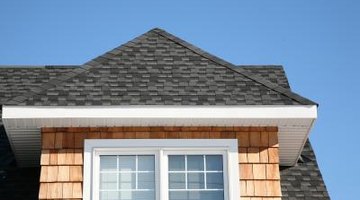What Kind of Nails Do I Use With Roof Sheathing?
Roof sheathing prepares your roof prior to the installation of shingles. Sheathing also serves as added protection against wind, rain, snow and ultraviolet sun rays. Using the proper hardware to install sheathing is especially important in hurricane-prone regions that experience extreme fluctuations in temperature. Poor fastening of sheathing can lead to leaks, unsightly bulges, or worse, total building failure during storms. Using a minimum of 8d common nails to securely fasten sheathing is recommended by the U.S. Federal Emergency Management Agency (FEMA).
Installation

Traditional sheathing material typically comprises 15/32-inch plywood or oriented-strand-board (OSB) panels. Builders generally use 8d common nails, which are approximately 2 ½ inches long and 131/1000 inch wide in diameter. The nails should be spaced no more than 6 inches apart and attached 3/8 inch from the sheathing panel ends and edges, according to the Engineered Wood Association. The association also recommends using 10d box nails as spacers to estimate 1/8-inch spacing between the end of the sheathing panel and edge joints.
Considerations
When installing sheathing, drive nails securely into the framing members. Aim the nail in the middle, rather than at the edge of the member. This ensures that the nail is fastened securely and will not dislodge from the member or sheathing panel. Also, avoid overdriving the nails into the rafter, which can weaken the connection between the sheathing and trusses. In addition, use ring-shank or screw-shank nails along edges, eaves and ridges, and deformed-shank nails throughout the entire roof.
Warnings
If you live in a region with high wind force, do not use staples to attach roof sheathing. Engineering studies have proven that stapling often fails to hold down sheathing during hurricanes and high-wind storms. Detached sheathing panels endanger your home’s structure, as well as the occupants in it. FEMA advises using properly sized screws on sheathing for additional withdrawal strength against extreme elements such as strong winds.
Expert Insight
One of the most common reasons nails uplift and pop out of roofs is due to incorrect fastening combined with poor installation, according to nationally syndicated newspaper columnist Tim Carter. Using the proper nails to ensure that shingles are securely attached to sheathing is just as important for extending the lifetime of your roof. For example, sometimes roofing nails penetrate sheathing along the seams where the two panels meet. Because the nail is driven into a sheathing area where there is little wood, the roofing nail can back out of the roof sheathing and eventually through the shingle itself. Constant contraction and expansion caused by heating and cooling cycles also push nails out of roofs. To protect your sheathing and roof, Carter advises using roofing nails that extend approximately 3/8 inch past the bottom of the sheathing panels.
Writer Bio
Bridgette is an aspiring yogini, newbie coder and seasoned marketing writer in the higher ed space. She's written hundreds of articles on a wide range of topics including, entrepreneurship, K-12 pedagogy and information technology. Bridgette's work has appeared on Connect: IT at NYU, Noodle Pros, QuickBooks Small Business Center, Trails.com and USA Today.
Photo Credits
- Jupiterimages/Photos.com/Getty Images
More Articles


